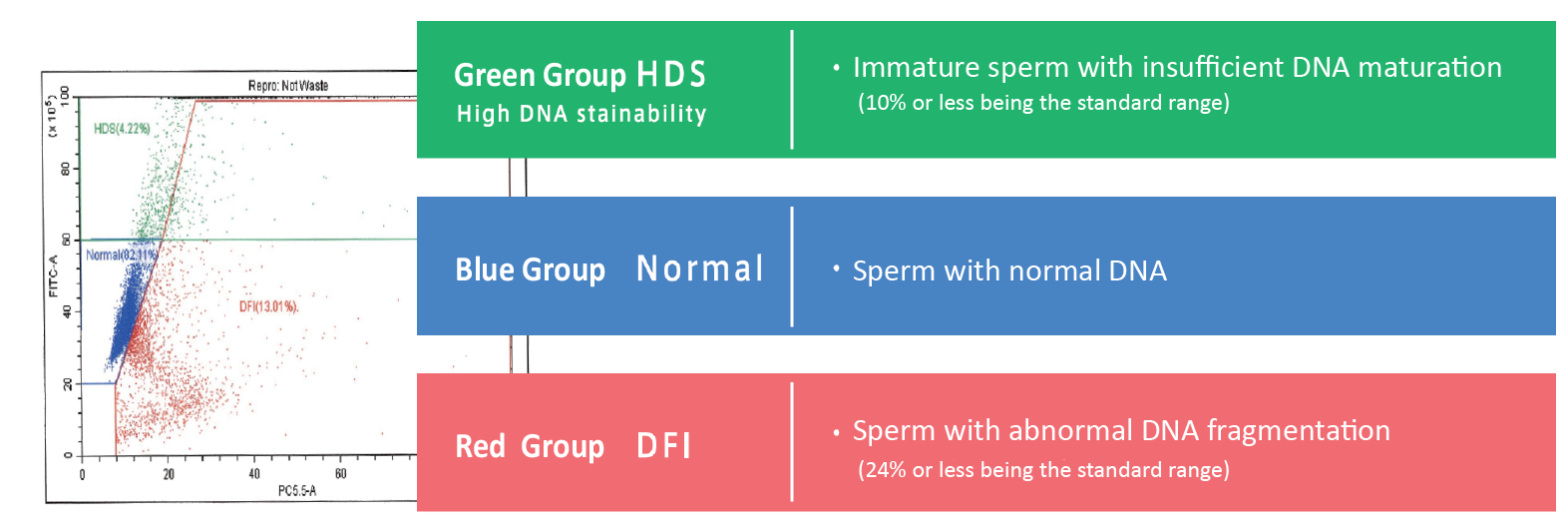Although general semen tests are important for predicting male fertility and considering treatment strategies, the quality and functionality of sperm cannot always be revealed by regular testing.
Therefore, more detailed evaluation of sperm quality is growing in importance to the field of reproductive medicine.
The latest World Health Organization (WHO) Lab Manual 6th Edition adds new items to assess sperm quality, including the DFI test and the ORP test.
DFI test: Sperm DNA fragmentation index test
This test determines the sperm DNA fragmentation index (DFI) as well as the percentage of sperm with immature sperm nuclei (HDS).
According to research, high DFI reduces fertility, hinders embryonic development, lowers the odds of pregnancy, and increases the risk of miscarriage as well as the frequency of offspring abnormalities.
DFI also increases with age regardless of other factors.
Infertile men also have a higher rate of HDS than normal men, suggesting that they have significant levels of impaired spermatogenic function.
High rates of HDS are associated with reduced fertility, reduced embryo quality, and lower pregnancy rates.
Immaturity of sperm DNA nuclei is also associated with miscarriage.
When sperm are stained and measured with an inspection device, normal sperm are classified into blue, DNA-damaged sperm are classified into red, and immature sperm are classified into green, and the proportions of each can be examined.
DFI of 24% or less and HDS of 10% or less are considered normal.

ORP test: Oxidation Reduction Potential test
This test measures the redox potential (oxidative stress level) in semen.
ORP (Oxidation Reduction Potential) is a redox potential, which shows the relationship between oxidative substances and antioxidants, and is considered to be an index of oxidative stress, which is a major cause of sperm DNA damage.
Studies have shown that males with infertility are more likely to have high levels of reactive oxygen species in their semen and low levels of antioxidants.
The WHO also recognizes oxidative stress as an important parameter that contributes significantly to male infertility, and its assessment and management is important for the treatment of male patients.
When oxidative stress in semen is high (1.38 mv or more per sperm concentration), it is considered imperative to improve lifestyle factors and take antioxidant supplements to reduce oxidative stress.
Recommended in the following situations
-
Men who have poor semen analysis findings and cannot find the cause.
-
Couples who have good semen analysis findings but still do not get pregnant easily.
-
Couples suffering from low fertilization rate and poor embryonic development.
-
Couples with repeated miscarriage.
-
Men over 40 years old (DFI tends to increase with age, but even younger men may have higher DFI values).
-
Men who have or have had varicocele surgery.
How to submit a sample
Please collect semen in the container you received and submit it.
You can either collect it at your own home or have it collected at our hospital (do not use condoms).
More accurate results will be obtained if you bring it within 2 hours after collection.
*Even in the case of doing the DFI test + ORP test set, it is possible to test both with one sample.
*If the amount of semen remaining after the initial semen analysis test is less than 0.3 ml, you will not be able to undergo the test.
*If the sperm concentration is less than 1 million / ml, accurate results cannot be obtained and the test results are for reference only.
Fees
DFI Test:¥12,000(With tax ¥13,200)
DFI Test + ORP Test set:¥17,700(With tax ¥19,470)
*In either case, a separate semen test fee is required in addition to these test fees.
*It is not possible to have only ORP inspection.
*The price including tax is listed based on a legal obligation to display the total amount. Actual costs may vary after final calculation.







